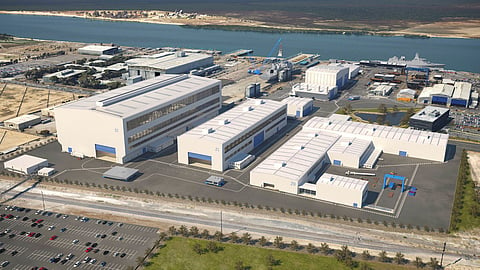

In its 50‑page review of the implementation of Australia's naval shipbuilding program, the Australian National Audit Office managed to avoid using the word "shambles". That's more than I can manage. Australia is only at the starting line of a multi-decade undertaking, but there are already plenty of reasons to worry.
The auditors are generous in saying that the Defence Department is, "on track to deliver the Offshore Patrol Vessel, Future Frigate and Future Submarine programs", though they note that it's still early days. But when we look at the first of the programs to kick off – the building of 12 offshore patrol vessels (OPVs) – it's hard to see a lot of positives. For a start, Australia is saddled with a plan that builds the first two vessels in one state, and then moves to another state, with another builder in another yard, for the remaining 10. That's not something shipbuilders would normally choose to do.
The "split build" approach is a government-mandated decision, and is a legacy of the gap between the construction of three air warfare destroyers and nine future frigates for the navy. The rationale for what's described as a "medium risk" approach is keeping part of the workforce in the government-owned shipyards in Adelaide skilled up.
Austal out
Meanwhile, Austal, the nation's most efficient shipbuilder – the only company to export a naval vessel from Australia in the past 20 years – is now absent from the build altogether after failing to reach an agreement with the prime contractor. That development leaves Austal without any domestic government work.
Unless it's successful in winning some work in the future frigate program, business planning will likely see the future of the company's Australian assets come under scrutiny, given that it also has shipyards in the US and the Philippines. Presumably there were commercial reasons for the company to miss out on the OPVs but, given that the whole program is already driven by maintaining skills in the sector rather than economic rationality, a little extra skewing wouldn't have been a surprise.
The auditors also note that the governance arrangements for the expenditure of some $90 billion aren't yet clear. That's alarming, given that recent and imminent decisions will lock in effective monopolies for decades. The worst-case scenario is that Australia ends up with less diversity in its shipbuilding sector, and with huge contracts over which the commonwealth has little future leverage.
Insufficient thought has gone into planning such a colossal enterprise and Australia is rushing ahead without the right structures in place. The following passage in the audit report is extraordinary:
"Defence has advised the government of its assessment that the naval construction programs carry high to extreme risk [related] to the delivery of expected capability, program cost, ability to meet program schedules, and management of the industrial base. The Naval Shipbuilding Plan did not address the management of these risks in any detail. However, Defence advised the ANAO that these risks will be managed by the individual shipbuilding programs."
The notion that enterprise-wide risks can be managed piecemeal within contracted build projects is just plain wrong. The whole rationale for the expansion of the domestic naval shipbuilding sector and continuous building was the holistic management of workflows and capability delivery. It looks a lot like they're making this up as they go along.
The audit's main recommendation concerns establishing the affordability of the shipbuilding enterprise, and identifying capability trade-offs elsewhere in defence investment required to fund shipbuilding. In other words, they think that the funding envelope remains underdeveloped in current plans, and that the cost of building ships in Australia could crowd out other investment in our defence forces in the decades to come.
The right strategic bet?
It's not surprising that costs aren't firm yet, when the design for the future submarine hasn't been finalised and the government is yet to choose a designer/builder for the future frigates. But the auditors are right to worry about the potential impact on the rest of the force. By establishing shipbuilding as a perpetual national enterprise, which necessarily requires continuous funding, they're essentially making warships a higher priority than other defence capabilities. That's a big strategic bet in light of developments in anti-ship missiles in recent years.
It's not clear that the government is fully aware of the squeeze that its long-term commitment to shipbuilding could place on future force structures. And it's not clear that it's getting advice along those lines from the Defence Department. In its response to the audit report, the department said that it, "takes an enterprise approach for Naval Construction Programs. The shipbuilding provisions identified in the Integrated Investment Program are consolidated for government to consider the Naval Construction Program affordability as each project is presented to government.
It also goes on to say, "Offsets are recommended to government if there is a shortfall between the funding requirement and existing provision."
That's at best a partial solution to what's likely to be a perpetual problem. If I read that correctly, each time a shipbuilding project goes to government, Defence provides a running total for the overall bill, and offers up cuts elsewhere in Defence's investment program. That's sustainable as long as the opportunity costs aren't too high, but what happens when shipbuilding starts to really bite into other ADF capability?
In summary, Australia has embarked on a "high to extreme" risk enterprise with inadequate governance and a piecemeal approach to the management of risk. It's intended to deliver a specific capability to the defence forces in perpetuity, crowding out other capabilities as it grows, independent of external strategic or technical developments. This is a shambles.
